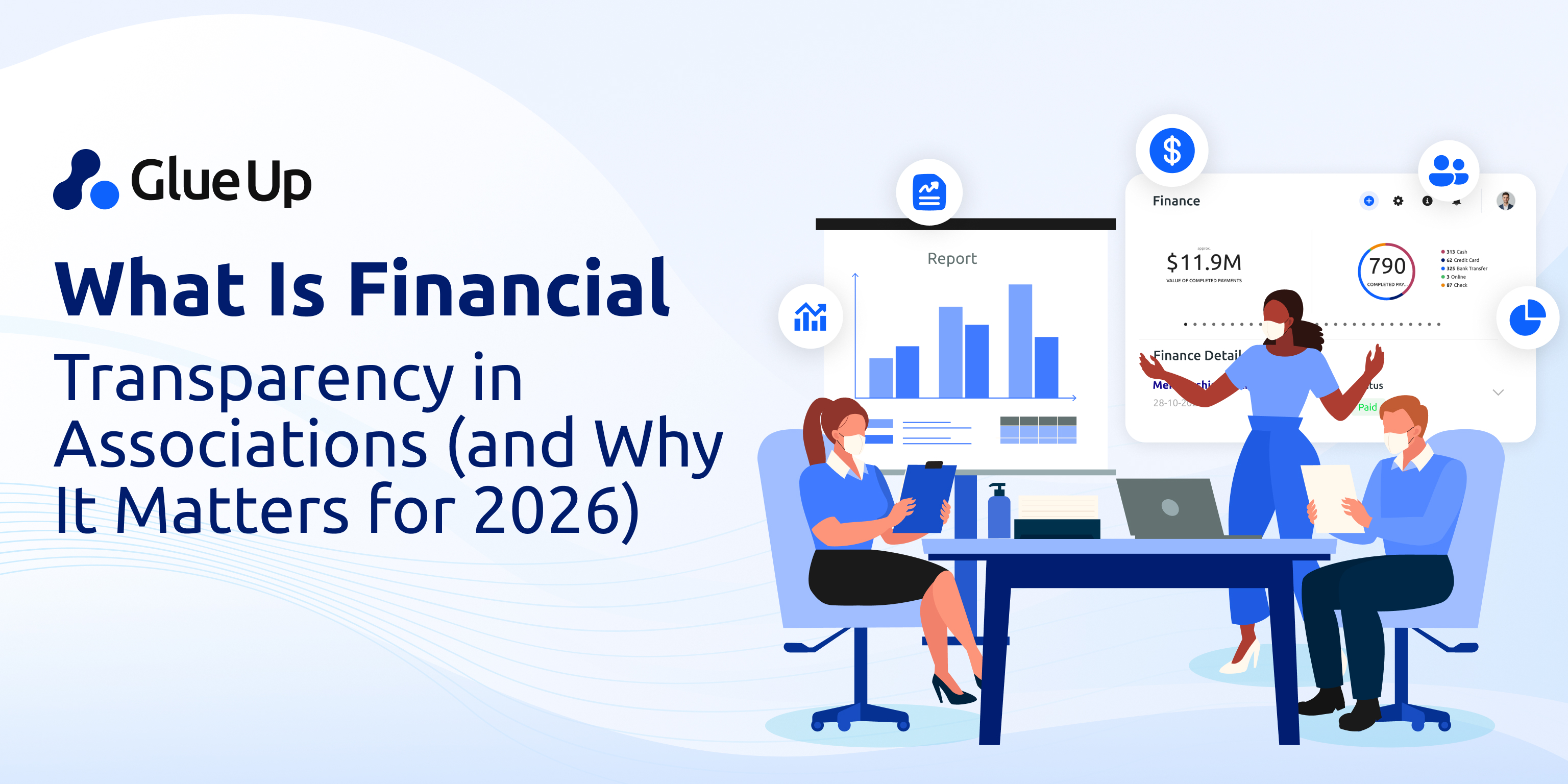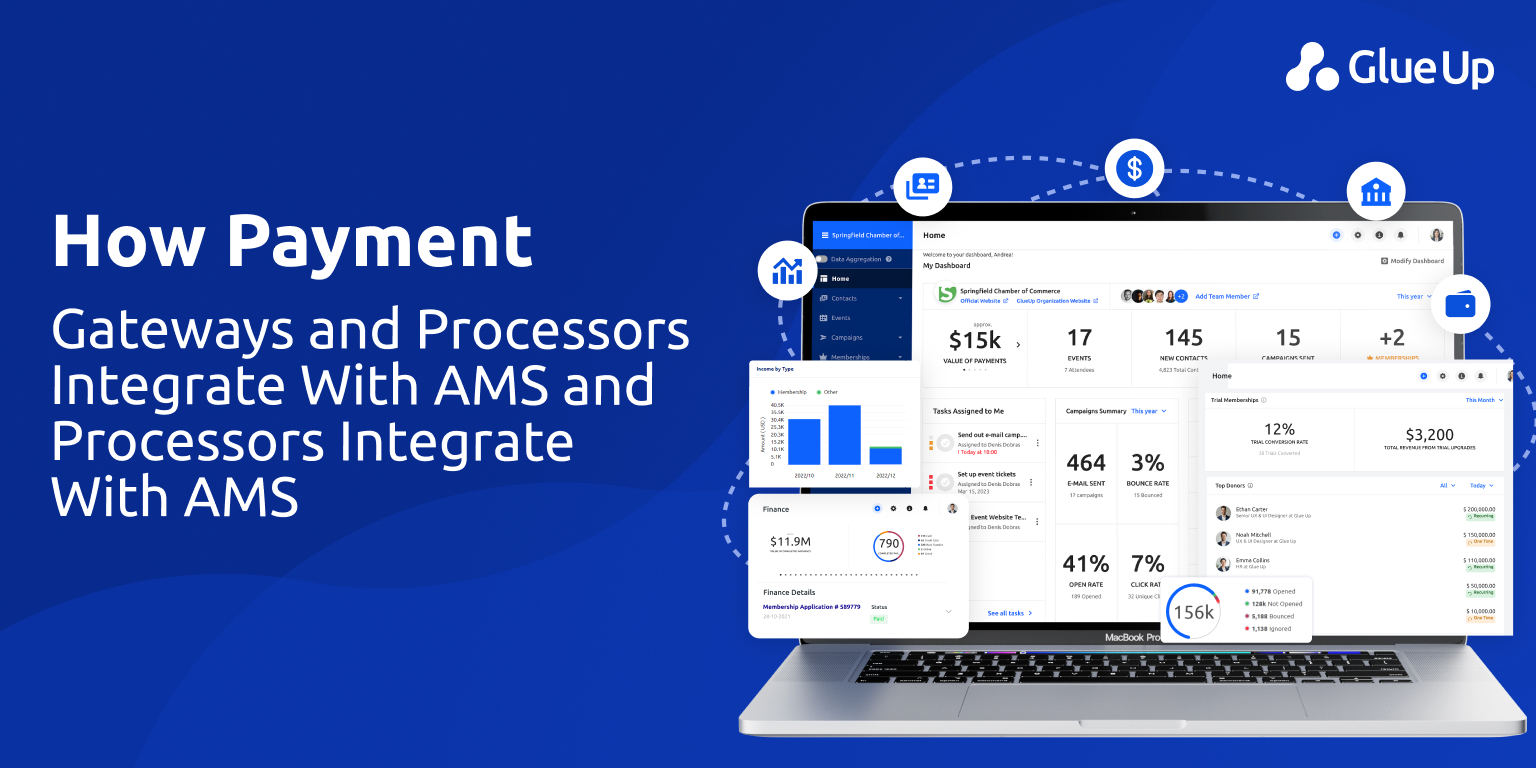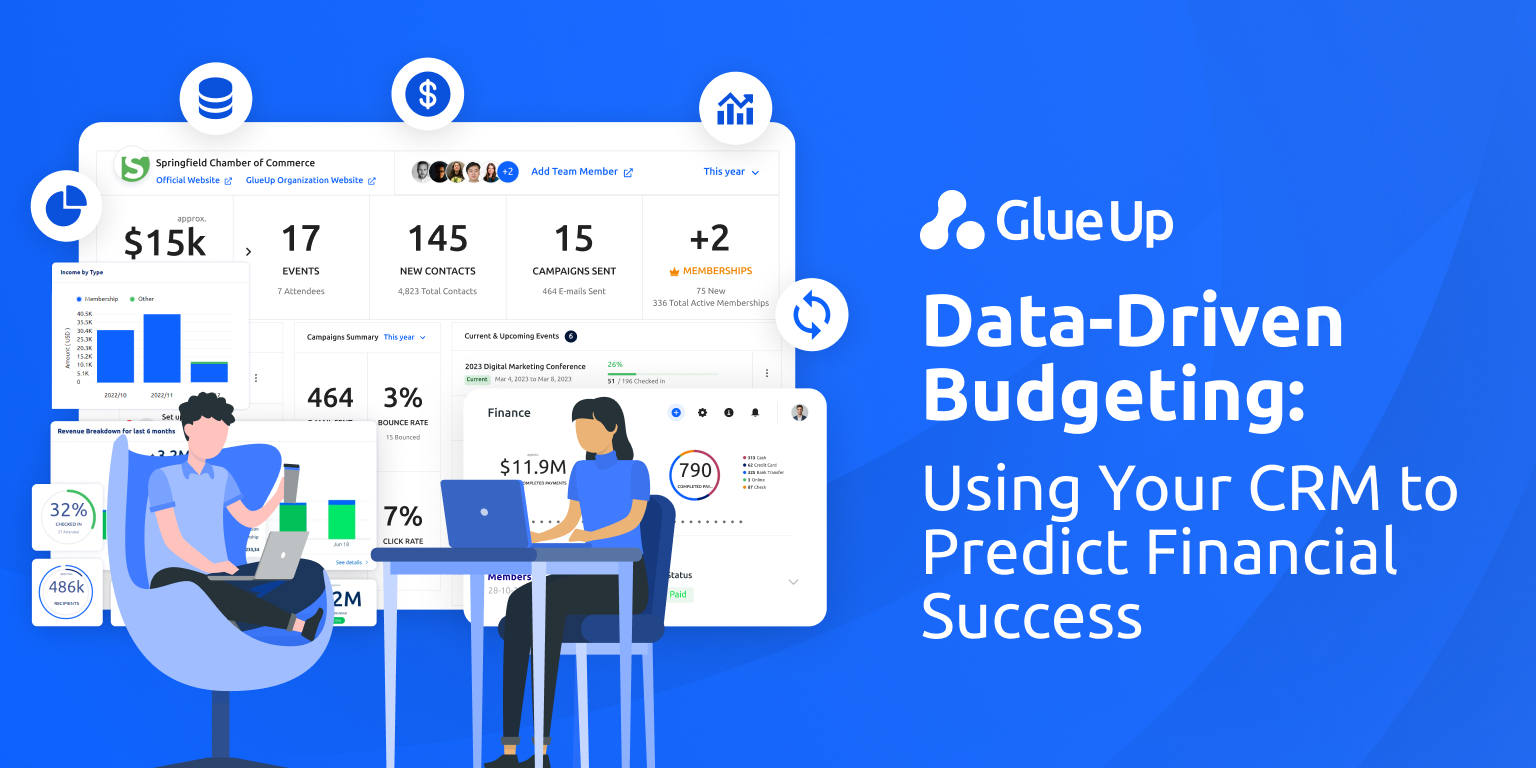
If you’re sitting in a board meeting of your association right now and one of your members asks, “Where exactly did our dues go this year?”, you may feel a familiar tightening in your chest. That is the moment when financial transparency shifts from being a buzzword to being your lifeline.
In 2026, associations can no longer treat financial transparency as a nice-to-have. It is the foundation of trust, the currency of credibility, and the difference between an organization that thrives and one that quietly erodes.
Key Takeaways
Financial transparency is the new trust currency. In 2026, associations can’t rely on reputation alone, members demand clarity on how dues are used. Transparent reporting builds credibility, strengthens renewals, and turns finance into an engagement tool rather than a compliance task.
A one-page financial dashboard is your proof of stewardship. Real transparency happens when data is visible, timely, and understandable. A concise dashboard showing key metrics lets boards and members see health at a glance and trust decisions instantly.
Consistent communication prevents financial mistrust. When budget shifts happen, explaining context, decision, and impact turns anxiety into confidence. Members don’t expect perfection, they expect honesty. Routine updates and narrative context make financial transparency a conversation.
Internal controls make transparency credible. Publishing numbers without governance is performative. COSO-aligned controls, independent finance committees, segregation of duties, and secure, role-based access (SOC 2-verified vendors) ensure the data behind your transparency is trustworthy.
Technology is the enabler. Cloud accounting, automated dashboards, and platforms like Glue Up connect membership, event, and finance data into one secure ecosystem. When systems talk, transparency stops being a chore, and becomes your strongest competitive advantage.
Quick Reads
Benefits of Transparent Budgeting for Associations • Glue Up
Boards Prioritizing Financial Transparency in 2026 • Glue Up
The Context Of 2026 and Why Financial Transparency Matters
In the past decade, associations (whether chambers of commerce, professional societies, or non-profit membership bodies) have faced growing demands for openness. The public is no longer satisfied with a simple annual report tucked behind a “members only” login. The era of delayed PDFs and opaque accounting is ending. The shift is driven by a combination of three converging trends: regulatory change, technology maturity, and cultural expectation.
On the regulatory front, legislation like the Financial Data Transparency Act (FDTA) has begun to standardize how organizations disclose financial information in machine-readable form and how quickly that data must be exposed (GFOA, 2025). Even if your association is not directly subject to FDTA, the ripple effect is clear: stakeholders expect the same discipline in your disclosure as the public corporations face.
Technology now means that you don’t have to wait for year-end close to publish insights. Cloud accounting, membership-event-finance integrations, dashboards that refresh monthly or even weekly: these are no longer futuristic, they are baseline.
Finally, cultural expectation: today’s members are more comfortable with data. They track their own investments, they get their news in real time, they demand transparency of organizations they invest in, financially and emotionally. As research from the Independent Sector shows, perceived financial transparency correlates directly with organizational trust and sustained engagement (Independent Sector, 2025).
Put it all together and you get the message: if your association isn’t visibly managing its money, your members may assume you’re not respecting it. Financial transparency is your signal that you are serious about stewardship.
What Does Financial Transparency Mean For Associations
Let’s strip away the jargon and layout what financial transparency really means in a member-based organization.
Openness: you publish not just the numbers but the narrative, how revenues convert into programs, how reserves buffer risk, how surpluses or deficits happened.
Timeliness: you share consistently and predictably. A dashboard every quarter matters far more than a perfect annual report delivered six months late.
Usability: you make the information easy to understand, navigate, and act upon. If your members feel they need an accountant to interpret your disclosures, you’ve missed the point.
For associations, achieving all three isn’t easy, but the reward is significant. Think of it this way: financial transparency turns your ledger into a conversation with your members rather than a ledger they ignore. When members believe they see the money, they feel they own the money, and that’s powerful.
Why Financial Transparency Matters for Member Based Organizations
For member-based organizations, your members are your customers, your community, your board, your advocates. Financial transparency matters for three major reasons:
Trust and Retention
When the budget is hidden or unclear, you create an information vacuum. Members fill that vacuum with guesswork, and often with imagination that trends toward suspicion. On the other hand, when you publish clearly, when you show how every dollar aligns with the mission, you build affinity. Renewal rates go up. Words like “I’m confident they’re good stewards of my membership dues” are spoken instead of “I’m not sure what they do with my money.”
Strategic Decision Making
Transparency drives inward behavior. If your leadership knows the dashboard is visible and readable, the finance team is more disciplined, the board more engaged, and the conversation about resources sharper. The result: more strategic allocation, better risk management, and stronger adaptability when the environment shifts.
Mission Credibility and Growth
Associations that are open about their financials appear modern, professional, and credible. Sponsors and partners notice. Members tell peers. Media and trade publications pick up the story of “this association that shows its numbers.” That kind of visibility attracts talent, attracts money, and enables growth.
In short, financial transparency is not optional in 2026, it is essential for mission delivery, growth, and resilience.
Building The One-Page Financial Dashboard Your Board Will Read
You understand the why and the what. Now let’s talk about the how. One way to make financial transparency tangible is to build a one-page dashboard. Here’s a step-by-step blueprint tailored for associations:
Step 1: Define audience and cadence
Decide whether this dashboard is for your board (monthly), senior staff (monthly), members (quarterly). Use the same layout every time so readers become familiar and can spot trends.
Step 2: Select eight to ten metrics that matter
Choose metrics that reflect the health of your organization:
Cash days on hand (liquidity)
Operating reserve in months
Dues vs non-dues revenue split (growth)
Membership renewal rate
Cost to acquire a member
Program-to-admin expense ratio (efficiency)
Event margin or net revenue
Budget variance (actual vs budget)
Keep the list short, focus on what will inform conversation.
Step 3: Wire the metrics to live data
Link your accounting system, your membership system, your event system. Automation reduces risk and frees your team from manually hunting numbers. Cloud-based accounting and dashboards are now accessible and cost-effective.
Step 4: Use activity-based costing
Tag staff time and overhead to actual programs and events. That way, when you show margins, they reflect reality. This makes your numbers credible and insightful (Associations Forum, 2024).
Step 5: Design for readability
Create trend lines (12 months), variance highlights (traffic-light colors: green/amber/red), and a short summary paragraph: “What changed this quarter and why.”
Step 6: Publish, update, and version
Put the dashboard in a known place. Name it clearly: “Q1 2026 Financial Dashboard – Version 1.0”. Be consistent in how and where you publish. Predictability builds trust.
By following this blueprint, you turn financial transparency from aspiration into action.
Reports Members Expect and How You Deliver with Clarity
Your members may not demand spreadsheets, but they expect clarity. Here are the reports they want, and how you can deliver them with precision:
Audited financial statements + annual report (once a year): This is the foundation. If you publish this, you have met the minimum. But minimum isn’t enough in 2026.
IRS Form 990 or equivalent: Even if it’s just filed and public, include a plain-English summary: “Here’s what you’re seeing, here’s what it means.” (Jitasa Group, 2024)
Quarterly one-page summary (dashboard): This is where you increase transparency and differentiate your organization.
Budget highlights and narrative: Before the fiscal year begins, publish a summary: “This is how we plan to allocate resources” plus a link to the detailed budget. After six months, publish updates: “Here’s what changed.”
Member Q&A or FAQ" A simple “Why did dues increase?” or “What happens to our reserves?” section shows openness and invites conversation.
Delivery tips:
Use plain language. Don’t assume members know financial jargon.
Include visuals: pie charts, trend lines, bullets.
Use the same formatting each time so the report becomes routine rather than a surprise.
Link to archived dashboards so readers can compare year-on-year.
Communicating Budget Changes Without Losing Trust
Nobody likes surprises, especially when the surprise is “our budget is cut 10%.” But saying “we must cut 10%” without context is worse than saying nothing. Here’s how to communicate budget changes in a way that builds trust rather than erodes it:
Provide context: “Over the past six months we saw a 15 % decline in event sponsorship revenue, which triggers this change.”
Explain the decision: “We are reducing program X by 5 %, reallocating resources to Y, and maintaining reserves at the six-month level.”
Illustrate the impact on members: “Here’s what will change next year: fewer face-to-face workshops, but more virtual training offered at no extra cost.”
Commit to follow up: “We will report on these changes in our Q2 dashboard and update you in six months on progress.”
Invite feedback: “We welcome your questions on this and will host a web-briefing next month.”
When you follow this framework, you turn a budget change into a narrative of stewardship.
Internal Controls That Make Financial Transparency Real
Transparency is the processes that make the numbers trustworthy. Without robust controls, transparency becomes risky. Here are key internal controls your board should ensure are in place by 2026:
Adopt the COSO Internal Control Framework model: control environment, risk assessment, control activities, information & communication, monitoring (CBH, 2024).
Establish a finance & audit committee comprised of independent board members (not staff or related parties). Meets quarterly.
Enforce segregation of duties: approval, execution, and reconciliation handled by different people.
Maintain a policy suite: reserves policy, procurement policy, conflicts of interest, travel & expense policy, vendor management.
Use vendor security attestations: cloud tools ★must★ have role-based access control (RBAC), SOC 2 Type II or similar reports (AuditBoard, 2025).
Regularly review the one-page dashboard and full statements: the board should ask questions.
Conduct periodic external audits or reviews, not just because you must, but because you will make those findings public.
When these controls are strong, your transparency is credible; when they are weak, your transparency is superficial, and folks sense the difference.
Tech Tools To Publish Transparent Financials Securely
In 2026, you can’t rely on spreadsheets and PDF dumps. To meet the transparency expectations, you need tools that connect data, secure access, and automate refreshes.
Member-facing portal: Publish dashboards, annual reports, supporting documents in one place. Use analytics to see who’s engaging.
Board portal: Role-based access for reports, minutes, dashboards. Audit logs show who saw what when.
Cloud accounting system: Real-time integration. Minimizes manual errors and supports automation.
Dashboard tool: Connect accounting + membership + event data so you can show, for instance, “membership revenue per event” or “cost to acquire a new member.”
Security and vendor compliance: Ensure any tool that stores financial or personal data is certified SOC 2, ISO 27001, or equivalent. Use RBAC and multi-factor authentication (MFA).
Automated publication workflows: When month-end close finishes, the dashboard refreshes, is reviewed and posted automatically. No waiting for “someone to do it.”
Glue Up’s integrated platform, where membership, events, and communication data live together, can simplify this link between raw data and published transparency, helping you move from “raw ledger” to “public narrative” faster.
Checklist For Associations To Elevate Financial Transparency
Here’s your practical take-away: a checklist you can lift, adapt, and share. Use this to move from concept to implementation.
| Step | Action |
|---|---|
| Owner named | Assign a transparency lead (staff or board) who owns cadence, publishing, and issues. |
| Cadence locked | Board: monthly; Senior staff: monthly; Members: quarterly. Publish schedule and stick to it. |
| Packet standardized | Annual report + audited statements; quarterly one-pager; budget highlight; FAQ. |
| Tag transactions | Use activity-based costing: staff time and overhead tied to programs/events. |
| Feedback loop defined | After each report, invite member questions and post responses in next cycle. |
| Controls hardened | Finance & audit committee, segregation of duties, policies refreshed for 2026. |
| Security proven | Member portal: RBAC + MFA; vendor tools: SOC 2 or equivalent; audit logs on access. |
| Dashboard published | One-page with key metrics, trend lines, narrative summary. Posted in known location. |
| Narrative tied to action | When you publish numbers, always accompany with “what we did,” “why it matters.” |
| Measure engagement | Track how many of your members click, open, comment, renew. Transparency is only meaningful if people see and use it. |
The Future of Financial Transparency in Associations
If you lean in now, transparency becomes an asset. If you delay, you risk being left behind. Here are some trends to watch:
Real-time, member-driven dashboards: Members logging into their apps to see “our association’s health” alongside their own membership history.
Benchmarking networks: Associations sharing financial openness data across sectors, creating peer-driven transparency standards.
Narrative + data convergence: Annual reports become interactive stories. Hover over a number, get explanation, click to view program case study.
AI and predictive transparency: Forecasting dashboards that say not only “this is what we did” but “this is where we’re headed, and here are the risks.”
Member-driven oversight: Hybrid models where volunteers or members validate dashboards (“Yes, these numbers reflect what I saw in the field”).
These are emerging now. Associations that start building these capabilities will lead the pack.
A Board Room, A Member, A Dashboard
Imagine: The chair of your board clicks on the link, the one-page dashboard opens on the large screen. It shows the past 12 months’ metrics: cash days, renewal rate, budget variance. The CFO says, “Here’s how we allocated your dues, here’s how we performed against plan, and here’s what we’re doing next.” A member leans forward and says: “Thank you for showing us this.” For the first time in your association’s history, the conversation isn’t “What did you do?” but “How do we go further together?”
That moment, when your numbers become clarity, when your report becomes a conversation, that’s when financial transparency has done its job.
Your association is ready for 2026. Are you ready to show the numbers, tell the story, and lead the community?



